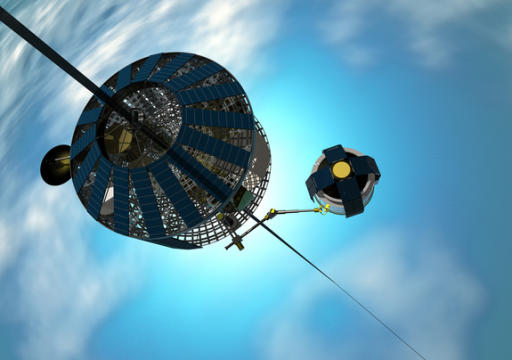
An electric-powered climber spacecraft rides up the space elevator.
An elevator to the moon might not be as crazy as it sounds. A moon-based elevator to space could radically reduce the costs and improve the reliability of placing equipment on the lunar surface. Such a lunar elevator would make the transport of supplies and materials from the surface of the moon into the Earth's orbit and vice versa possible. Indeed, valuable resources could be extracted from the moon, then sent into Earth's orbit.It's no pie in the sky project according to the LiftPort Group of Seattle, Wash. A LiftPort strategic framework calls for establishing an operational Lunar Space Elevator Infrastructure (LSEI). The project would involve commercial, off-the-shelf technology, and a single heavy-lift launch solution.
LiftPort's concept for building the lunar space elevator infrastructure calls for using a climbing vehicle that scoots up and down a ribbon-shaped, tethered cable that's part of an anchor station secured to the airless moon.
A lunar elevator provides value by making soft landings on the moon possible. The group envisions a rocket launched from Earth to a Lagrange Point PicoGravity Lab, where cargo is transferred to the robotic lifter and gently delivered to the moon's surface. Once fully functioning, the lunar elevator could soft-land equipment and people on the moon's landscape. Using forecast models, backers of the LSEI see transport of three-dozen people to the moon per year as attainable in the early years of the elevator's operation.
"We're making steady progress," said Michael Laine, president of the LiftPort Group.
He has been encouraged by NASA's newly announced Lunar Cargo Transportation and Landing by Soft Touchdown program, which is intended to spur commercial cargo transportation capabilities to the surface of the moon. Moreover, funds from a recent Kickstarter campaign have enabled LiftPort to focus on the lunar elevator idea.
"The prospects for a future Earth space elevator are brighter now … but there are challenges remaining," said Jerome Pearson, president of STAR, Inc., based in Mount Pleasant, S.C. He is an early originator and supporter of space elevator concepts. Pearson said that the tough-to-do challenge list includes at least a few items: producing the vast quantities of high-strength carbon nanotube composites required; the dynamics of the 100,000-km-long structure; and the problems of debris in low Earth orbit that could destroy the space elevator ribbon. Pearson's ElectroDynamic Debris Eliminator (EDDE) project aims to do something about the space debris. He believes the EDDE, a maneuvering spacecraft, could remove all the dangerous debris — over 10 centimeters (4 inches) in diameter — from low-Earth orbit by about 10 to 15 years from now.
But the long and short of it, Pearson said, is that engineers need to understand the dynamics of such lengthy structures before they can risk building the Earth space elevator.
"Lunar development will provide for mining regolith, lunar polar water and possibly helium-3 for nuclear power, so I fully expect that we will have a lunar space elevator by around 2025, and that it will pave the way for building the Earth space elevator," he concluded.
A letter-writing campaign to the U.S. Congress, initiated by lunar scientists late last year, has urged reclaiming the moon for both scientific and commercial use. Among key points, the letters said that the moon has abundant resources that can be used to dramatically reduce the cost of solar system exploration, and can also be used to stimulate new industries and technologies (i.e., creating new jobs) for mining, extracting, storing and using these resources to facilitate lunar industry and exploration beyond the moon.
The Earth's moon is a treasure trove of mineral resources, such as precious metals, rare earth elements, helium-3 and oxygen for propellants," said Charles Radley, a technical advisor to the LiftPort Group. However, landing on the moon currently carries a high price tag. But by using modern fibers, space agencies could construct a lunar elevator that reduces the cost of lunar landing six-fold, he said.
The lunar elevator represents a "game-changing technology" that will open up the moon to commercial mining, Radley said. "The lunar elevator could reduce the cost of lunar mining of some commodities to a par with terrestrial mining."
Furthermore, a lunar-situated elevator makes the cost of collecting material from the moon and sending it to Earth essentially free, Radley said. The lunar elevator will pay for itself after 19 payload cycles.
Helium-3, sells for a million dollars per ounce on the secondary market. Demand far exceeds supply. It is abundant on the moon but rare on Earth. U.S. supplies are rationed by the White House and will be exhausted by 2030. Turning to rare earth elements that are vital to defense and high technology industries, Radley said that today, 96 percent of them come from China.
"There are few alternatives, but the moon is one."
No comments:
Post a Comment
Through this ever open gate
None come too early
None too late
Thanks for dropping in ... the PICs